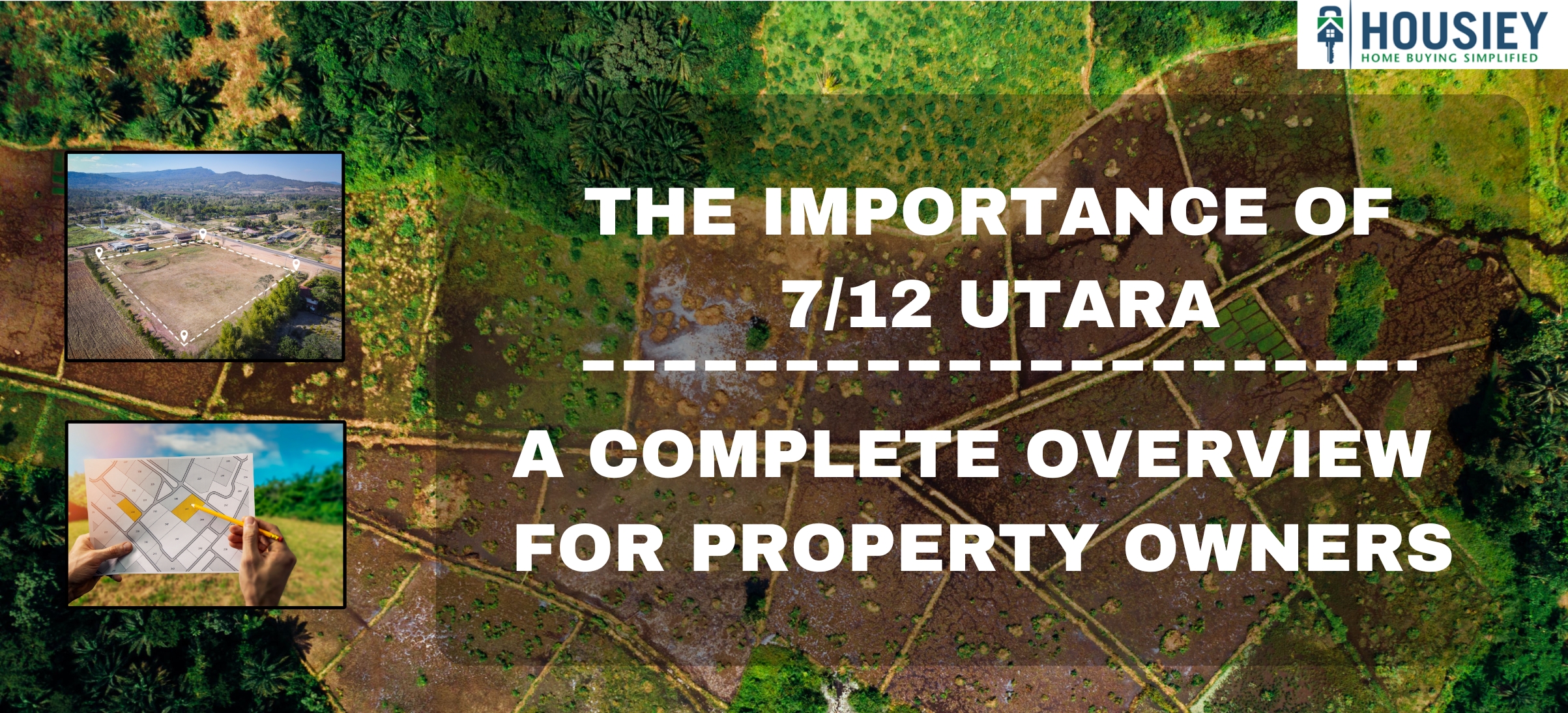When it comes to land and property ownership in Maharashtra, one of the most important terms you’ll encounter is 7/12 Utara. This document is more than just a piece of paper—it is a vital record that defines ownership, usage, and rights over agricultural land. Often referred to as “Satbara Utara” in local parlance, it plays a crucial role in every land-related transaction in the state.
In this blog, we will dive deep into every aspect of the 7/12 extract, from its meaning, significance, and usage, to how to obtain it online, its comparison with other land records, and even its regional adaptations in states like Tamil Nadu. This guide aims to cover all aspects systematically so that you have complete clarity on why this document matters and how it impacts property ownership.
What is 7/12 Utara and What Does it Mean?
The term 7/12 Utara refers to an extract from the land records maintained by the revenue department of Maharashtra. It is called “7/12” because it combines information from two forms:
- Form 7: Records details of the owner(s) of the land.
- Form 12: Captures details of the agricultural aspects of the land, such as cultivation type, crops grown, and soil type.
Together, these forms give a comprehensive snapshot of both ownership and usage of agricultural land. In simple words, 7/12 meaning can be described as a consolidated land record that shows who owns the land and how the land is being used.
Why is the 7/12 Document Important?

The 7/12 document importance lies in the fact that it serves as an official proof of land ownership and agricultural activity. It is required for:
- Establishing legal ownership of land.
- Securing agricultural loans from banks.
- Resolving disputes over property.
- Determining land tax liabilities.
- Verifying property details during transactions.
In Maharashtra, no agricultural land transaction is considered valid without producing a proper 7/12 extract.
How to Get 7/12 in Maharashtra?

Many landowners and buyers often ask, how to get 7/12 in Maharashtra? The process has been digitized under the Maharashtra Bhulekh portal, which makes land record access easier.
Steps include:
- Visit the official Maharashtra Bhulekh website.
- Choose the district, taluka, and village.
- Enter property details such as survey number or owner name.
- Download the extract after verification.
This facility has made it extremely convenient for citizens to access 7/12 extract online, reducing dependence on physical visits to the revenue office.
What Details Does the 7/12 Extract Contain?

The 7/12 records provide a wealth of information, including:
- Name of the landowner.
- Survey number and area of the land.
- Details of cultivation and crops.
- Type of land (irrigated or non-irrigated).
- Encumbrances, disputes, or loans attached to the land.
This information is crucial for both buyers and financial institutions conducting due diligence.
How to Do a 7/12 Land Record Search?
If you want to verify ownership, conduct a 7/12 land record search online through the Maharashtra Bhulekh portal. By entering the survey or gat number, the platform generates accurate ownership and usage details.
This is particularly useful during property search 7/12, where potential buyers want to ensure there are no disputes or hidden liabilities associated with the land.
What is the Difference Between 7/12 and RTC?

A common query is about the difference between 7/12 and RTC. RTC, or Record of Rights, Tenancy, and Crops, is a similar land ownership record used in states like Karnataka.
- 7/12 extract (Maharashtra): Focuses on ownership and agricultural usage.
- RTC (Karnataka): Provides details about tenancy, ownership, and cultivation rights.
In some places, the term RTC 7/12 Maharashtra is used informally to compare the two, though technically, Maharashtra follows the 7/12 system.
What About 7/12 Details in Tamil Nadu?

Interestingly, land record systems vary across states. While Maharashtra uses 7/12 extracts, Tamil Nadu uses its own system of land record management. People often search for 7/12 details Tamil Nadu, but instead, Tamil Nadu offers a Patta-Chitta document that serves a similar purpose.
Thus, while the concept is the same—recording ownership and usage—the format differs across states.
How to Update 7/12 Online?
Changes in ownership, crop type, or encumbrances must be updated in the land records. Thankfully, the Maharashtra government provides an update 7/12 online service.
Property owners can submit applications digitally with supporting documents such as sale deeds, mutation records, or inheritance proofs. After verification, the updated records are reflected in the extract.
How Does 7/12 Work for Land Ownership?
The 7/12 for land ownership acts as primary proof of who owns the land. However, it must be supported by registered sale deeds and property tax records. Banks, courts, and government bodies use it as a reference while verifying claims of ownership.
This is why no property transaction is complete without cross-verifying the 7/12 extract.
Can You Download the 7/12 Form?
Yes, citizens can access 7/12 form download through the Maharashtra Bhulekh portal. The PDF copy is digitally signed and can be used for most legal and financial purposes. This digital option has drastically reduced delays and paperwork.
What is the Role of Digitally Signing 7/12?
The introduction of digitally signing 7/12 has added a layer of security to prevent fraud. A digital signature ensures that the document is tamper-proof and legally valid.
Banks, courts, and registration authorities now accept digitally signed extracts as authentic.
What is the Relevance of the 7/12 Village Map?

Another valuable feature is the 7/12 village map, which gives a graphical representation of land parcels in a village. It helps in:
- Identifying boundaries.
- Understanding survey numbers.
- Verifying adjacent properties.
This is especially useful for disputes or large-scale land development projects.
What About 7/12 Records in Mumbai?
Urban areas like Mumbai also maintain mumbai 7/12 records for lands classified as agricultural in the past or those lying on city outskirts. While Mumbai has more reliance on city survey extracts, the 7/12 is still crucial in peri-urban zones where land is transitioning from agricultural to non-agricultural usage.
What is the Significance of Online 7/12 Entries?
The online 7/12 entries initiative ensures that all mutations, ownership changes, and crop details are updated electronically. This reduces delays, prevents corruption, and provides transparency to landowners.
Conclusion
The 7/12 Utara is not just a bureaucratic formality but a backbone of Maharashtra’s land record system. From proving ownership to verifying crop details, it plays a vital role in legal, financial, and administrative processes. The digitization of 7/12 records, integration with Maharashtra Bhulekh, and the introduction of digitally signed 7/12 documents have revolutionized land governance, making it more transparent and accessible.
Whether you’re a farmer, landowner, or property buyer, understanding and verifying your 7/12 extract online is a non-negotiable step in safeguarding your rights.
At Housiey, we believe in empowering homebuyers and landowners with clarity and transparency.
If you found this guide useful, we strongly recommend you also check out our in-depth blog on the CIDCO Housing Scheme, which can open up opportunities for affordable housing in Maharashtra.
FAQs
When it comes to land and property ownership in Maharashtra, one of the most important terms you’ll encounter is 7/12 Utara. This document is more than just a piece of paper—it is a vital record that defines ownership, usage, and rights over agricultural land. Often referred to as “Satbara Utara” in local parlance, it plays a crucial role in every land-related transaction in the state.
In this blog, we will dive deep into every aspect of the 7/12 extract, from its meaning, significance, and usage, to how to obtain it online, its comparison with other land records, and even its regional adaptations in states like Tamil Nadu. This guide aims to cover all aspects systematically so that you have complete clarity on why this document matters and how it impacts property ownership.
What is 7/12 Utara and What Does it Mean?
The term 7/12 Utara refers to an extract from the land records maintained by the revenue department of Maharashtra. It is called “7/12” because it combines information from two forms:
- Form 7: Records details of the owner(s) of the land.
- Form 12: Captures details of the agricultural aspects of the land, such as cultivation type, crops grown, and soil type.
Together, these forms give a comprehensive snapshot of both ownership and usage of agricultural land. In simple words, 7/12 meaning can be described as a consolidated land record that shows who owns the land and how the land is being used.
Why is the 7/12 Document Important?

The 7/12 document importance lies in the fact that it serves as an official proof of land ownership and agricultural activity. It is required for:
- Establishing legal ownership of land.
- Securing agricultural loans from banks.
- Resolving disputes over property.
- Determining land tax liabilities.
- Verifying property details during transactions.
In Maharashtra, no agricultural land transaction is considered valid without producing a proper 7/12 extract.
How to Get 7/12 in Maharashtra?

Many landowners and buyers often ask, how to get 7/12 in Maharashtra? The process has been digitized under the Maharashtra Bhulekh portal, which makes land record access easier.
Steps include:
- Visit the official Maharashtra Bhulekh website.
- Choose the district, taluka, and village.
- Enter property details such as survey number or owner name.
- Download the extract after verification.
This facility has made it extremely convenient for citizens to access 7/12 extract online, reducing dependence on physical visits to the revenue office.
What Details Does the 7/12 Extract Contain?

The 7/12 records provide a wealth of information, including:
- Name of the landowner.
- Survey number and area of the land.
- Details of cultivation and crops.
- Type of land (irrigated or non-irrigated).
- Encumbrances, disputes, or loans attached to the land.
This information is crucial for both buyers and financial institutions conducting due diligence.
How to Do a 7/12 Land Record Search?
If you want to verify ownership, conduct a 7/12 land record search online through the Maharashtra Bhulekh portal. By entering the survey or gat number, the platform generates accurate ownership and usage details.
This is particularly useful during property search 7/12, where potential buyers want to ensure there are no disputes or hidden liabilities associated with the land.
What is the Difference Between 7/12 and RTC?

A common query is about the difference between 7/12 and RTC. RTC, or Record of Rights, Tenancy, and Crops, is a similar land ownership record used in states like Karnataka.
- 7/12 extract (Maharashtra): Focuses on ownership and agricultural usage.
- RTC (Karnataka): Provides details about tenancy, ownership, and cultivation rights.
In some places, the term RTC 7/12 Maharashtra is used informally to compare the two, though technically, Maharashtra follows the 7/12 system.
What About 7/12 Details in Tamil Nadu?

Interestingly, land record systems vary across states. While Maharashtra uses 7/12 extracts, Tamil Nadu uses its own system of land record management. People often search for 7/12 details Tamil Nadu, but instead, Tamil Nadu offers a Patta-Chitta document that serves a similar purpose.
Thus, while the concept is the same—recording ownership and usage—the format differs across states.
How to Update 7/12 Online?
Changes in ownership, crop type, or encumbrances must be updated in the land records. Thankfully, the Maharashtra government provides an update 7/12 online service.
Property owners can submit applications digitally with supporting documents such as sale deeds, mutation records, or inheritance proofs. After verification, the updated records are reflected in the extract.
How Does 7/12 Work for Land Ownership?
The 7/12 for land ownership acts as primary proof of who owns the land. However, it must be supported by registered sale deeds and property tax records. Banks, courts, and government bodies use it as a reference while verifying claims of ownership.
This is why no property transaction is complete without cross-verifying the 7/12 extract.
Can You Download the 7/12 Form?
Yes, citizens can access 7/12 form download through the Maharashtra Bhulekh portal. The PDF copy is digitally signed and can be used for most legal and financial purposes. This digital option has drastically reduced delays and paperwork.
What is the Role of Digitally Signing 7/12?
The introduction of digitally signing 7/12 has added a layer of security to prevent fraud. A digital signature ensures that the document is tamper-proof and legally valid.
Banks, courts, and registration authorities now accept digitally signed extracts as authentic.
What is the Relevance of the 7/12 Village Map?

Another valuable feature is the 7/12 village map, which gives a graphical representation of land parcels in a village. It helps in:
- Identifying boundaries.
- Understanding survey numbers.
- Verifying adjacent properties.
This is especially useful for disputes or large-scale land development projects.
What About 7/12 Records in Mumbai?
Urban areas like Mumbai also maintain mumbai 7/12 records for lands classified as agricultural in the past or those lying on city outskirts. While Mumbai has more reliance on city survey extracts, the 7/12 is still crucial in peri-urban zones where land is transitioning from agricultural to non-agricultural usage.
What is the Significance of Online 7/12 Entries?
The online 7/12 entries initiative ensures that all mutations, ownership changes, and crop details are updated electronically. This reduces delays, prevents corruption, and provides transparency to landowners.
Conclusion
The 7/12 Utara is not just a bureaucratic formality but a backbone of Maharashtra’s land record system. From proving ownership to verifying crop details, it plays a vital role in legal, financial, and administrative processes. The digitization of 7/12 records, integration with Maharashtra Bhulekh, and the introduction of digitally signed 7/12 documents have revolutionized land governance, making it more transparent and accessible.
Whether you’re a farmer, landowner, or property buyer, understanding and verifying your 7/12 extract online is a non-negotiable step in safeguarding your rights.
At Housiey, we believe in empowering homebuyers and landowners with clarity and transparency.
If you found this guide useful, we strongly recommend you also check out our in-depth blog on the CIDCO Housing Scheme, which can open up opportunities for affordable housing in Maharashtra.
FAQs












